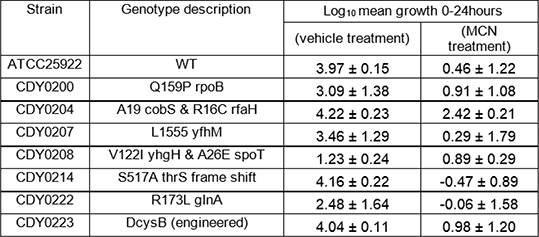Print version
Search Pub Med
| 061P London, UK Pharmacology 2016 |
The role of mecillinam pharmacokinetics in the ability to treat resistant E. coli infections in the neutropenic mouse thigh infection model.
Introduction: Despite a high resistance frequency in vitro, clinical resistance to the Penicillin binding Protein 2 (PBP2) inhibitor Mecillinam (MCN) is rare. To investigate this, we compared MCN resistant (MCNR) E. coli strains with wild type (WT, ATCC25922) for their ability to infect and be treated with MCN in vivo.
Methods: Minimal inhibitory concentration (MIC) values were determined by broth microdilution methods. Female CD-1 mice (approximately 20g, n=3-4 per group) were rendered neutropenic via intraperitoneal injections of cyclophosphamide, 4 days (150mg/kg) and 1 day (100mg/kg) before infection. Animals were infected with 1x105 colony forming units (cfu) via intramuscular infection into the left thigh. Two hours post infection (0 hours), treatment with vehicle or MCN was initiated via subcutaneous injection. To determine the 0 hour cfu/thigh, a cohort of animals was euthanized via CO2asphyxiation, the infected thigh excised, homogenised and the cfu/thigh determined. Remaining groups were analysed 24 hours later with drug concentrations measured over the course of the study. Colonies isolated from thigh homogenates were retested for MCN susceptibility. A Kruskall-Wallis ANOVA or Mann-Whitney t-test were used for statistical analysis.
Results: MCNR strain MIC values were ≥16 μg/ml compared to 0.25 μg/ml for WT. Overall, strains grew approximately 3-4 log10 over 24 hours in vehicle treated mice, the exception was CDY208 which demonstrated reduced growth. Following MCN treatment (320 mg/kg every 3 hours), bacterial levels were not significantly different from 0 hour values for all strains although CDY204 was 2-log10 above the baseline value (Table 1). Pharmacokinetic modelling showed free drug concentrations remained above 32 μg/ml for over 30% of the dosing interval.
Table 1. Growth (mean ± SD) over 24 hours in mice infected with E. coli WT and MCNR strains and dosed with vehicle or MCN Q3H at 320 mg/kg. A - ve value indicates bacterial levels were lower than those at 0 hours. Colonies isolated from an animal infected with WT and treated with MCN were found to be MCN resistant (MIC >32μg/ml). Whole genome sequencing identified mutations in cysB; ΔC at base position 379 resulting in truncation.

Conclusion: Here we demonstrated that despite differences in in vitro susceptibility and the apparent generation of in vivo resistance, MCNR strains could generally still be treated in vivo if a threshold above the highest MIC concentration was maintained. Such information can be used for prudent clinical dosing of antibiotics from this class and developing novel therapies to treat resistance.

